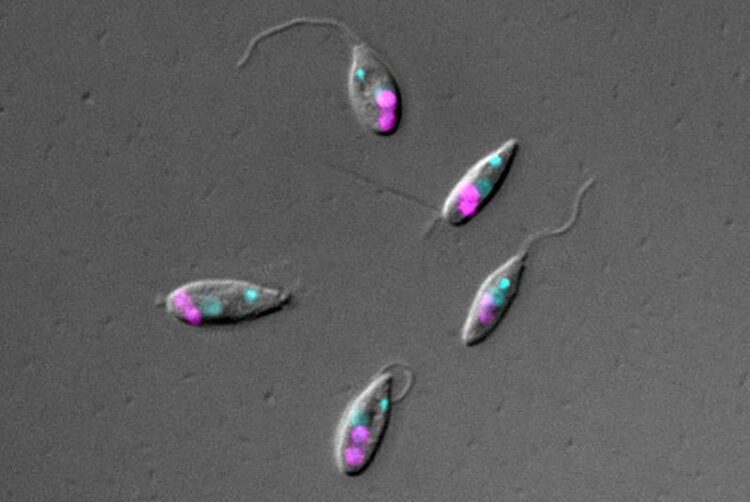How cells gain control over their bacterial symbionts

In the flagellate Angomonas deanei, a single-celled eukaryotic organism that lives in the intestines of insects, each cell contains a bacterial symbiont – shown here in magenta. The nucleus of the flagellate and its mitochondrial genome are shown in cyan.
HHU/Anay Maurya
Modern eukaryotic cells contain numerous so-called organelles, which once used to be independent bacteria. In order to understand how these bacteria were integrated into the cells in the course of evolution and how they are controlled, a research team from the Institute of Microbial Cell Biology at Heinrich Heine University Düsseldorf (HHU) has examined the single-celled flagellate Angomonas deanei, which contains a bacterium that was taken up relatively recently. In the journal Current Biology, the biologists now describe how certain proteins in the flagellate control the cell division process of the bacterium, among other things.
In the course of evolution, modern eukaryotic cells (cells with a nucleus), have taken up bacteria from their environment. The cells have brought the incorporated bacteria under their control and now utilise them for important functions such as metabolic processes. The bacteria have thus become cell organelles. Organelles which have arisen from such “endosymbionts” (symbionts within the cell) include mitochondria, the “powerhouses of the cell”, and chloroplasts, in which photosynthesis occurs in plants. This happened around 1.5 to 2 billion years ago.
Organelles, whose bacterial predecessors possessed their own genetic material, have significantly reduced their genome, meaning that they have become increasingly dependent on the host cell over time. Their metabolism, protein composition and reproduction are now largely controlled by the host organism.
But how did this adaptation process occur in evolutionary terms? To find out, the working group headed by Professor Dr Eva Nowack from the HHU Institute of Microbial Cell Biology examined Angomonas deanei, a flagellate that lives in the intestines of insects. This model organism is particularly well suited to answering this question as every one of these single-celled organisms contains just one symbiotic bacterium, which was incorporated in relatively recently (between 40 and 120 million years ago). This bacterium supplies the host with vitamins and certain metabolites.
Similar to mitochondria and chloroplasts, the genome of the bacterium is already reduced compared with its free-living relatives, but not yet to the same extent as in conventional organelles. The integration is however sufficiently advanced for cell division to occur synchronously: When the host organism divides, so does the bacterium – just once, with one part going into each new flagellate cell.
The Düsseldorf research team wanted to find out how the host cell controls the endosymbiont. They examined its protein composition and discovered that a certain number of proteins from the host cell are transferred to the endosymbiont. Three of these proteins form a ring around its division site.
The researchers were able to predict the function of two of these proteins by comparing them with known protein sequences. One of them is similar to the protein “dynamin”, which can polymerize into contractile helical chains. A further protein, the so-called peptidoglycan hydrolase, is known to be able to break down bacterial cell walls.
In mitochondria and chloroplasts, dynamin-like proteins also form a ring around the organelle division site and the contraction of this ring aids the fission of the organelles. In addition, the division of some chloroplasts requires a peptidoglycan hydrolase to break down the remnants of the bacterial cell wall at the division site of these organelles.
Professor Nowack: “Our work shows that a eukaryotic host cell can transfer certain proteins to the endosymbiont at a relatively early stage in the evolution of an endosymbiotic relationship. These proteins enable the cell to gain control over the symbiont.”
Originalpublikation:
Jorge Morales, Georg Ehret, Gereon Poschmann, Tobias Reinicke, Anay K. Maurya, Lena Kröninger, Davide Zanini, Rebecca Wolters, Dhevi Kalyanaraman, Michael Krakovka, Miriam Bäumers, Kai Stühler and Eva C. M. Nowack: Host-symbiont interactions in Angomonas deanei include the evolution of a host-derived dynamin ring around the endosymbiont-division site, Current Biology (2022).
DOI: 10.1016/j.cub.2022.11.020
Media Contact
All latest news from the category: Life Sciences and Chemistry
Articles and reports from the Life Sciences and chemistry area deal with applied and basic research into modern biology, chemistry and human medicine.
Valuable information can be found on a range of life sciences fields including bacteriology, biochemistry, bionics, bioinformatics, biophysics, biotechnology, genetics, geobotany, human biology, marine biology, microbiology, molecular biology, cellular biology, zoology, bioinorganic chemistry, microchemistry and environmental chemistry.
Newest articles

First-of-its-kind study uses remote sensing to monitor plastic debris in rivers and lakes
Remote sensing creates a cost-effective solution to monitoring plastic pollution. A first-of-its-kind study from researchers at the University of Minnesota Twin Cities shows how remote sensing can help monitor and…

Laser-based artificial neuron mimics nerve cell functions at lightning speed
With a processing speed a billion times faster than nature, chip-based laser neuron could help advance AI tasks such as pattern recognition and sequence prediction. Researchers have developed a laser-based…

Optimising the processing of plastic waste
Just one look in the yellow bin reveals a colourful jumble of different types of plastic. However, the purer and more uniform plastic waste is, the easier it is to…



